Japan Telecom Towers Market Size
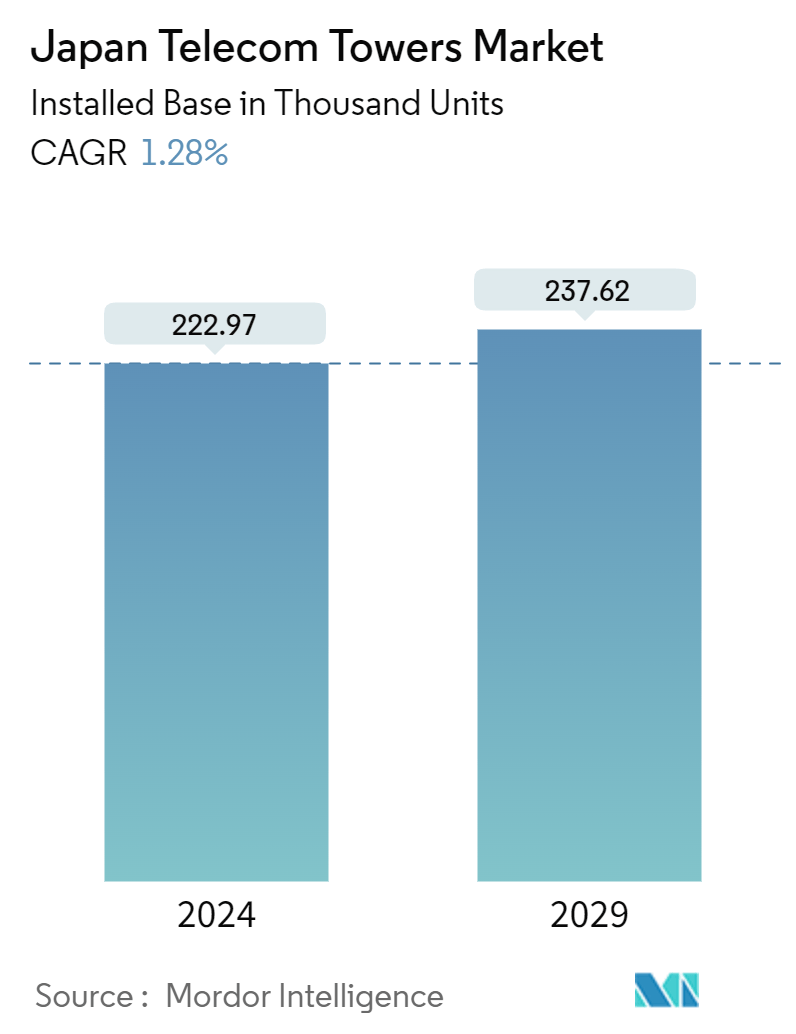
| Study Period | 2019 - 2029 |
| Base Year For Estimation | 2023 |
| Forecast Data Period | 2024 - 2029 |
| Historical Data Period | 2019 - 2022 |
| CAGR (2024 - 2029) | 1.28 % |
| Market Concentration | Medium |
Major Players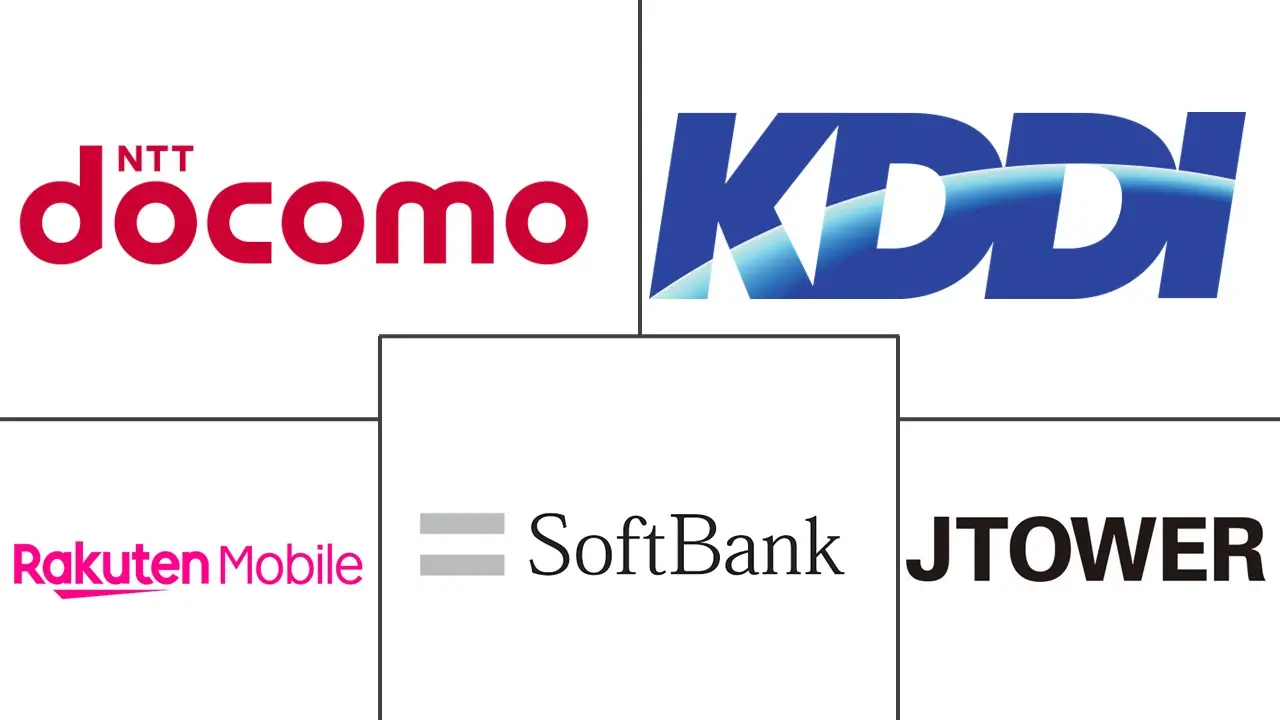
*Disclaimer: Major Players sorted in no particular order |
Japan Telecom Towers Market Analysis
The Japan Telecom Towers Market size in terms of installed base is expected to grow from 222.97 Thousand units in 2024 to 237.62 Thousand units by 2029, at a CAGR of 1.28% during the forecast period (2024-2029).
- Japan has a high mobile penetration rate, with a significant number of subscribers. The rising popularity of smartphones, coupled with increased data usage and a demand for reliable network coverage, is fueling the need for more telecom towers. This expansion aims to meet the country's growing mobile connectivity requirements. According to the Ministry of Internal Affairs and Communications (Japan), nearly 79% of the Japanese population owned a smartphone in 2023, marking a significant rise in smartphone penetration since the mid-2010s.
- Moreover, renowned for its cutting-edge telecommunication infrastructure, Japan has an extensive network of fiber-optic cables and high-speed broadband. As the appetite for high-speed internet and data services surges, telecom towers become pivotal in extending and optimizing wireless network coverage to cater to these demands.
- Additionally, Japan's urban areas are densely populated and witness a heightened demand for swift and reliable mobile connectivity. This demand supports individual communication and business and public service needs. Additional telecom towers are imperative to cater to these densely populated regions. For context, the World Bank notes that Japan's urbanization has stabilized at approximately 92.04% over the last decade. Given Japan's population of 126 million, this statistic indicates that under 10% reside outside urban locales. Japan's urbanization rate significantly surpasses the global average of 55%.
- Furthermore, leading the charge in technological innovations, Japan strongly emphasizes rolling out 5G networks. Telecom towers are vital for this 5G infrastructure, as they facilitate the small-cell technology essential for high-frequency transmissions. They also ensure the coverage and capacity needed to achieve the anticipated speeds and low latency of 5G. As of March 2024, the Ministry of Internal Affairs and Communications (Japan) reported nearly 92.4 million 5G subscriptions. Major mobile carriers in Japan, including NTT Docomo, KDDI, SoftBank, and Rakuten Mobile, commenced their commercial 5G rollouts in 2020, initially targeting urban centers.
- Additionally, given Japan's susceptibility to natural disasters like earthquakes, typhoons, and tsunamis, a robust telecom tower network becomes paramount. Such a network ensures communication lines remain open during and post-disaster events. Telecom towers, especially those with backup power, redundancy, and disaster recovery features, play a vital role in public safety and emergency responses. For instance, the National Research Institute for Earth Science and Disaster Resilience highlighted that in 2023, Japan faced six earthquakes with a magnitude of five or more, as per the Japan Meteorological Agency (JMA).
- However, telecom towers require an uninterrupted power supply to ensure 24x7 network availability, fulfilled mainly by electricity, batteries, and diesel generators. The environmental impact of telecom towers has always been a significant concern. Radiation from mobile towers has been an important issue, and it is recognized as an unseen and subtle pollutant affecting life forms in multiple ways. Moreover, using non-renewable sources to run power systems, such as diesel, significantly pollutes the environment.
Japan Telecom Towers Market Trends
5G is Expected to be a Catalyst for the Market's Growth
- The Japanese government expects 5G coverage to reach 99% of the population by the end of FY 2030. Smartphones and PCs are major contributors to the internet among populations and are expected to increase their penetration in the 5G era.
- Japanese Prime Minister Kishida presented his Vision for a Digital Garden City Nation, which seeks to achieve rural-urban digital integration and transformation to maintain future prosperity in the outlying regions of Japan and encourage many people around the world to gain a deeper understanding of and connection with the country's rural areas. One of the goals of the vision is to provide 5G service to 90% of the Japanese population by the end of FY2023 (March 31, 2024). It is expected that this will drive the country's Telecom Tower Market.
- By accelerating the rollout of 5G throughout the nation, Japanese telecom operator SoftBank hoped to raise JPY 35 billion (about USD 0.25 billion) to address social challenges in its home market. The money, known as a "Social Loan," will only be used to build 5G base stations. Although the project aims to address social issues in Japan, such advancements are expected to stimulate the country's telecom tower market, as the 5G developments require towers for antennas and stations.
- The government has been a pioneer in ICT initiatives. Strategies like e-Japan Phase I & II and the i-Japan Strategy 2015 focused on developing high-speed internet access, telecom towers, e-government, etc. These initiatives aimed to link the digital divide and adopt a digital society.
- With the primary goal of delivering local 5G networks in Japan, Cisco and partners JTower, Mitsui Knowledge Company (MKI), and Airspan Networks have developed a local 5G Open RAN (O-RAN) environment for in-building infrastructure sharing. Airspan's 5G vRAN, JTower's Local 5G in-building infrastructure sharing system, Cisco Private 5G, and MKI are used in the deployment, while MKI is in charge of building and testing the end-to-end 5G wireless environments. In the period under study, such innovations are anticipated to propel the Japanese telecom tower industry.
- In September 2023, NTT Docomo announced that a new master transaction contract had been concluded with Japan’s JTower. The agreement ensures a further 1,552 DOCOMO towers will be transferred to the Japanese towers and in-building solution provider following an early deal made in March 2022. The agreement is expected to be worth USD 114 million, and NTT stated it is actively working to build a viable 5G network by promoting infrastructure sharing. This transaction is expected to enable further streamlining of its network operations.
- The industry is witnessing collaborations or mergers as part of business expansions. For instance, in May 2023, NVIDIA and SoftBank Corporation collaborated on a pioneering platform for generative AI and 5G/6G applications that is based on the NVIDIA GH200 Grace Hopper Superchip and which SoftBank aims to roll out at new, distributed AI data centers across the country. Paving the way for the speedy, worldwide deployment of generative AI applications and services, SoftBank is expected to build data centers, in collaboration with NVIDIA, which can host generative AI and wireless applications on a multi-tenant common server platform, which decreases costs and is energy efficient.
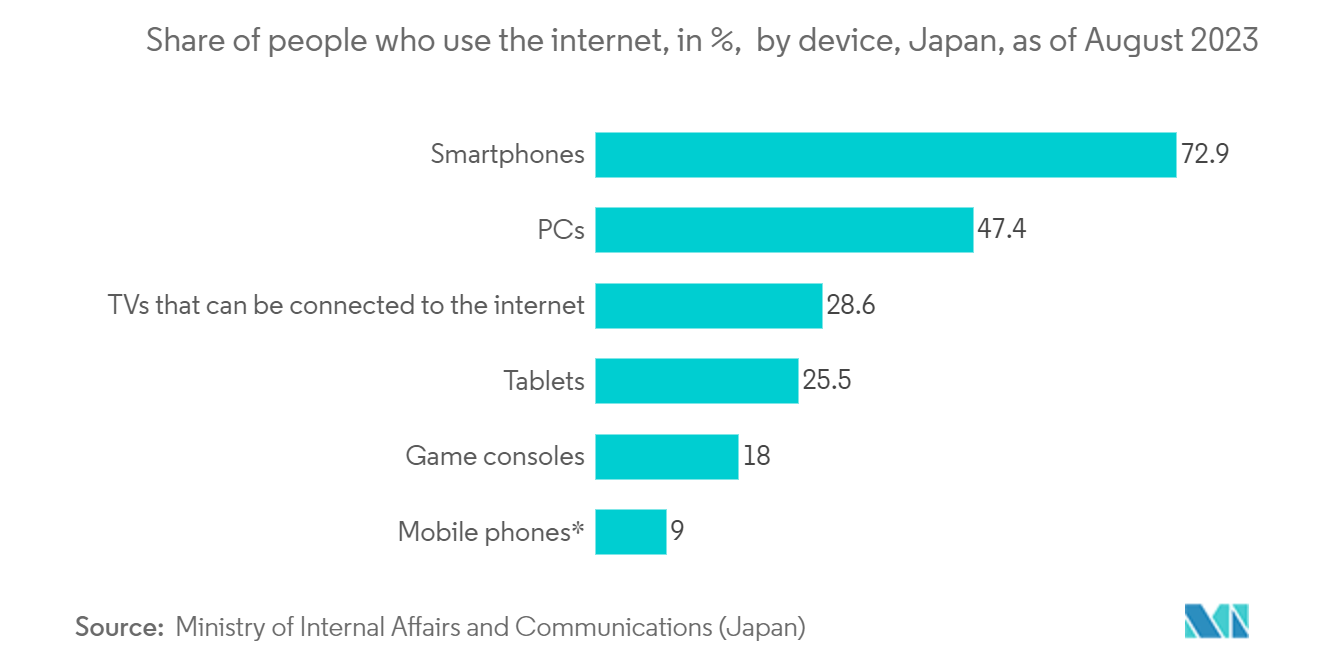
The Renewables Segment is Expected to Witness Growth in the Market
- Due to escalating liquid fuel and operational costs, telecom tower companies in Japan are increasingly embracing renewable energy sources. By adopting these green technologies, they can lower their operational expenses.
- Moreover, telecom towers utilize hybrid energy systems incorporating renewable technologies, such as solar photovoltaic panels, wind turbines, fuel cells, and microturbines. This transition reduces fossil fuel consumption and plays a crucial role in diminishing carbon emissions.
- With the telecommunications sector's rising demand for sustainable energy solutions, the renewable energy segment is set for swift expansion in the Japanese telecom tower market during the forecast period. As a fundamental support service, Telecommunications drives the rapid growth and modernization of various economic sectors.
- Historically, telecom providers have depended on diesel generators to address electricity supply shortages. While diesel power meets immediate demands, it comes with variable operational costs and increases greenhouse gas emissions. Transitioning to renewable energy not only aims to lessen diesel consumption but also holds the promise of diminishing or even eradicating the operational hours of diesel generators, thus further boosting revenue in this domain.
- The increased use of renewable energy sources and their associated benefits are projected to drive the market studied. Telcom companies in various regions use renewable energy sources to power their towers to reduce their carbon footprint. For instance, Jtower, a telecom infrastructure firm based in Japan, is broadening its infrastructure-sharing solutions. These solutions utilize shared telecom towers like NTT Docomo to assist network operators. This strategy supports network operators and diminishes environmental impact by reducing the necessity for multiple operators to construct separate towers.
- Furthermore, integrating renewable energy into telecom networks is a forward-thinking strategy. However, achieving sustainability goals demands robust collaboration among operators, infrastructure vendors, and suppliers, alongside the embrace of new business models. Accelerating the shift to clean energy hinges on innovations in the energy market and partnerships between government and private entities.
- The journey to net zero is heavily reliant on technological progress and embedding sustainability into business operations. Consequently, to mitigate emissions, telecom companies are progressively transitioning to renewable energy. This shift leads to significant cost savings and facilitates the profitable expansion of mobile networks into rural and sparsely populated regions.
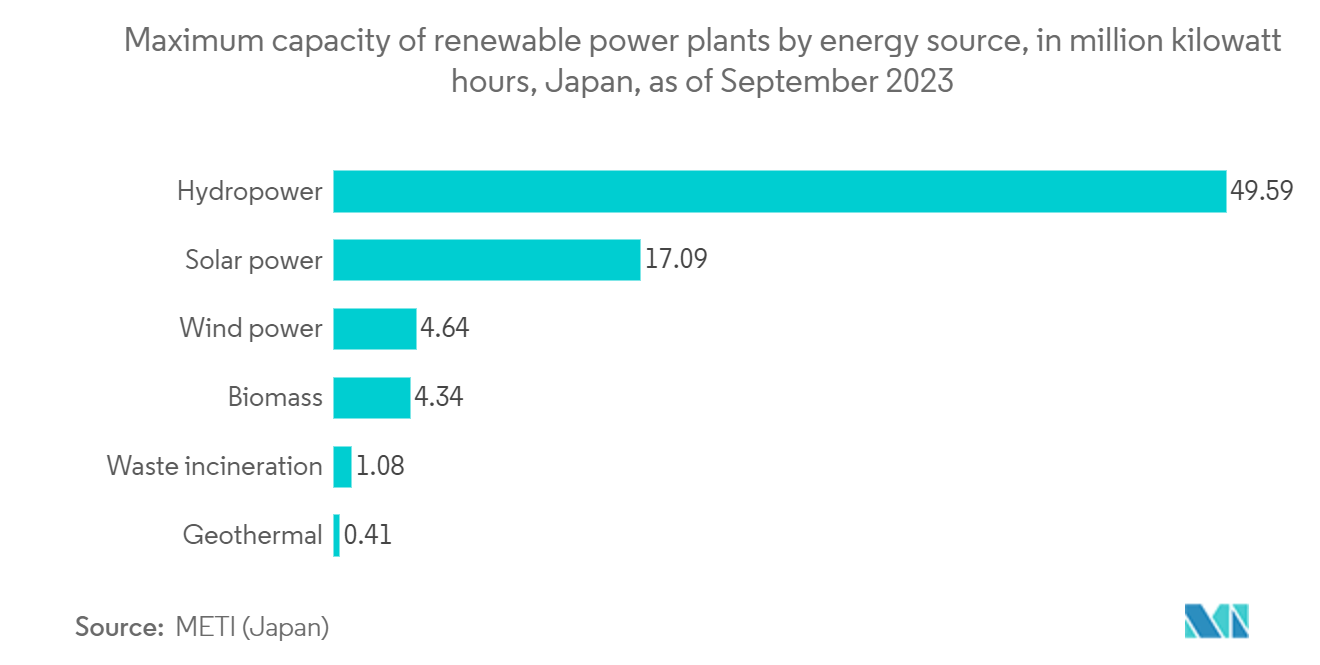
Japan Telecom Towers Industry Overview
The Japanese telecom tower market is highly consolidated and consists of very few players, such as NTT Docomo, KDDI, Softbank, and Rakuten Mobile. These major players in the Japanese telecom tower market are expanding their customer base through strategic collaborations and acquisitions of telecom tower startups. This has led to a moderately high market concentration, with a few dominant players benefiting from significant market share and profitability.
- August 2024: J Tower seeks a flexible funding partner to navigate the era of 6G and space-based communications. An infrastructure investor proposes a JPY 3,600 per share (USD 24.25 per share) offer for J Tower, significantly above its recent trading price. While J Tower's stock hovered around the JPY 1,500 (USD 10.10) mark for the past few months, it was valued at over JPY 6,000 (USD 40.42) a year ago.
- February 2024: SoftBank and Nvidia announced a new industry initiative to incorporate artificial intelligence (AI) with cellular technology. The aim is to utilize cell-phone transmission towers to process large amounts of data required by AI. The Japanese telecom company and the US chipmaker announced a mobile tech-related event in Barcelona. The companies stated that this collaborative group will be called the "AI-RAN Alliance." The companies stated that 11 firms and organizations worldwide will be partaking in a push to create a global standard. They include Microsoft, Amazon Web Services, Samsung Electronics, Ericsson of Sweden, and Finland's Nokia.
Japan Telecom Towers Market Leaders
-
NTT Docomo
-
KDDI Corporation
-
SoftBank Group Corp.
-
Rakuten Mobile, Inc.
-
JTOWER Inc
*Disclaimer: Major Players sorted in no particular order
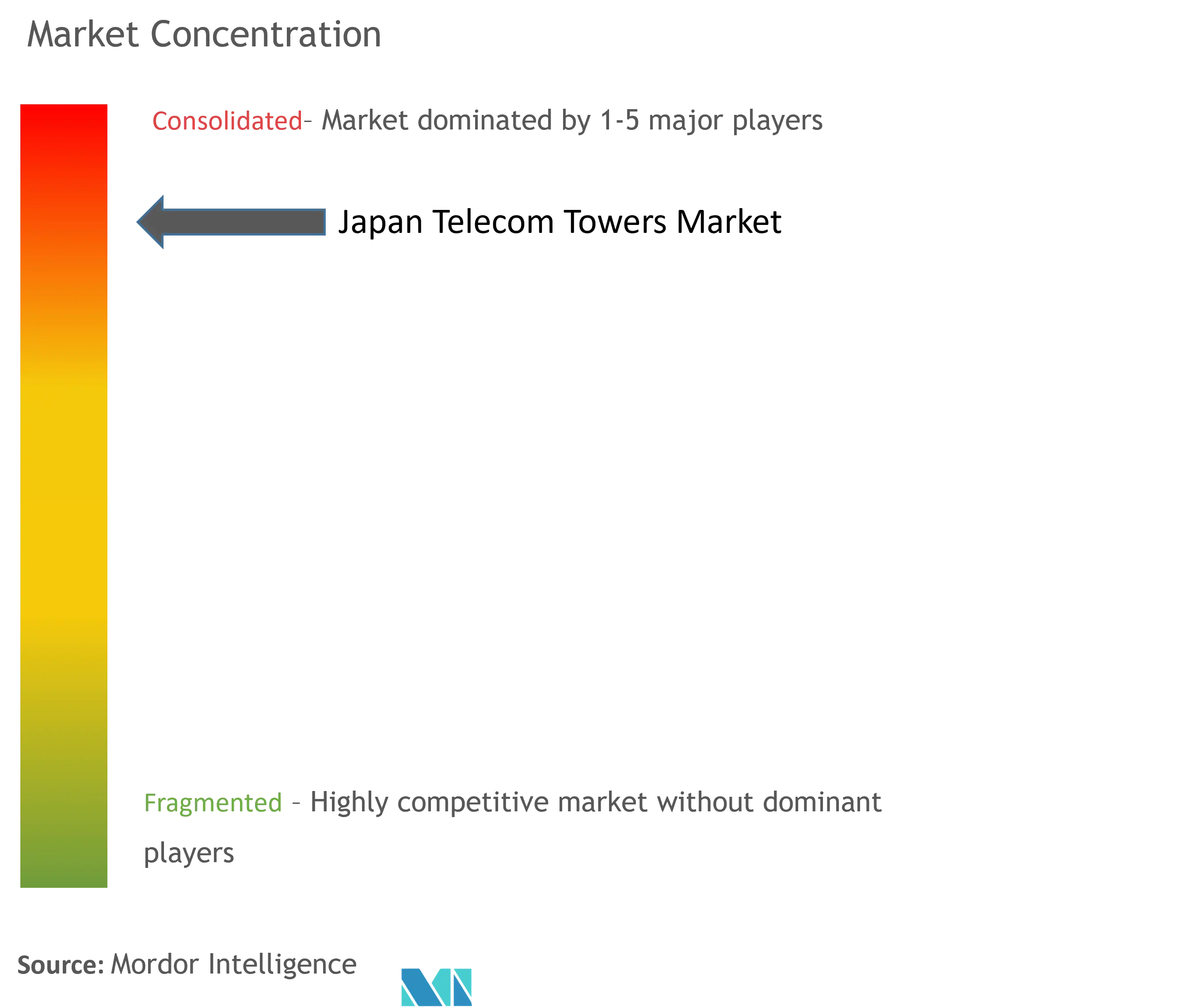
Japan Telecom Towers Market News
- August 2024: JTower, a Japanese tower operator, announced a glass antenna, asserting its capability to "transform windows into base stations" for 5G services in Tokyo. In an official statement, JTower revealed its collaboration with fellow Japanese carrier NTT DoCoMo and glass producer AGC. Together, they installed the innovative glass antenna at the Shinjuku 3Chome East Building in Tokyo, linking it to JTower's 5G carrier-neutral network infrastructure.
- February 2024: NTT Docomo, a telecom operator in Japan, is partnering with NEC to establish a joint venture. The goal is to expand the 5G open RAN networking gear business in international markets, with a focus on Southeast Asia and the Middle East. This move aims to challenge the long-standing dominance of industry giants like Huawei and Ericsson.
Japan Telecom Towers Market Report - Table of Contents
1. INTRODUCTION
- 1.1 Study Assumptions and Market Definition
- 1.2 Scope of the Study
2. RESEARCH METHODOLOGY
3. EXECUTIVE SUMMARY
4. MARKET INSIGHTS
- 4.1 Market Overview
-
4.2 Industry Attractiveness - Porter's Five Forces Analysis
- 4.2.1 Bargaining Power of Suppliers
- 4.2.2 Bargaining Power of Buyers
- 4.2.3 Threat of New Entrants
- 4.2.4 Threat of Substitutes
- 4.2.5 Intensity of Competitive Rivalry
5. MARKET DYNAMICS
-
5.1 Market Drivers
- 5.1.1 Improving Connectivity to Rural Areas
- 5.1.2 5G Deployments are a Major Catalyst for Growth in the Cell Tower Leasing Environment
- 5.1.3 Improving and Catering to Increasing Data Needs
-
5.2 Market Restraints
- 5.2.1 Environmental Concerns about Power Supply Systems to Towers
- 5.2.2 Tower Sharing Between Telecom Companies
6. TECHNOLOGY SNAPSHOT
- 6.1 Technology Snapshot
7. MARKET SEGMENTATION
-
7.1 Ownership
- 7.1.1 Operator-owned
- 7.1.2 Private-owned
- 7.1.3 MNO Captive
-
7.2 Installation
- 7.2.1 Rooftop
- 7.2.2 Ground-based
-
7.3 Fuel Type
- 7.3.1 Renewable
- 7.3.2 Non-renewable
8. COMPETITIVE LANDSCAPE
-
8.1 Company Profiles*
- 8.1.1 Rakuten Mobile Inc.
- 8.1.2 SoftBank Group Corp.
- 8.1.3 KDDI Corporation
- 8.1.4 Nippon Telegraph and Telephone Corporation
- 8.1.5 Internet Initiative Japan Inc.
- 8.1.6 JSAT Corporation
- 8.1.7 TOKAI Communications Corporation
- 8.1.8 Wowow Inc.
- 8.1.9 Okinawa Cellular Telephone Company
- 8.1.10 Mitsui & Co. Ltd
9. INVESTMENT ANALYSIS
10. FUTURE MARKET OUTLOOK
** Subject To AvailablityJapan Telecom Towers Industry Segmentation
Telecommunication towers come in various structures, such as monopoles, tripoles, lattice towers, guyed towers, self-supporting towers, poles, masts, and similar configurations. These towers house one or more telecommunication antennas, facilitating radio communications. They can be situated on the ground or atop a building, often including storage for equipment and electronic components. While these towers don't need constant staffing, they do require periodic maintenance. Driven by the rollout of 5G infrastructure, the expansion of telecom towers is poised to persist during the forecast period.
The Japanese telecom towers market is segmented by ownership (operator-owned, private-owned, and MNO captive), installation (rooftop and ground-based), and fuel type (renewable and non-renewable). The market sizes and forecasts are provided in terms of value (USD) for all the above segments.
| Ownership | Operator-owned |
| Private-owned | |
| MNO Captive | |
| Installation | Rooftop |
| Ground-based | |
| Fuel Type | Renewable |
| Non-renewable |
Japan Telecom Towers Market Research FAQs
How big is the Japan Telecom Towers Market?
The Japan Telecom Towers Market size is expected to reach 222.97 thousand units in 2024 and grow at a CAGR of 1.28% to reach 237.62 thousand units by 2029.
What is the current Japan Telecom Towers Market size?
In 2024, the Japan Telecom Towers Market size is expected to reach 222.97 thousand units.
Who are the key players in Japan Telecom Towers Market?
NTT Docomo, KDDI Corporation, SoftBank Group Corp., Rakuten Mobile, Inc. and JTOWER Inc are the major companies operating in the Japan Telecom Towers Market.
What years does this Japan Telecom Towers Market cover, and what was the market size in 2023?
In 2023, the Japan Telecom Towers Market size was estimated at 220.12 thousand units. The report covers the Japan Telecom Towers Market historical market size for years: 2019, 2020, 2021, 2022 and 2023. The report also forecasts the Japan Telecom Towers Market size for years: 2024, 2025, 2026, 2027, 2028 and 2029.
Japan Telecom Towers Industry Report
Statistics for the 2024 Japan Telecom Towers market share, size and revenue growth rate, created by Mordor Intelligence™ Industry Reports. Japan Telecom Towers analysis includes a market forecast outlook for 2024 to 2029 and historical overview. Get a sample of this industry analysis as a free report PDF download.



